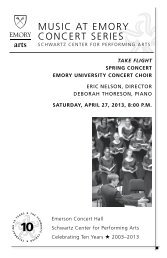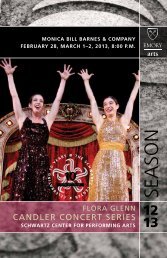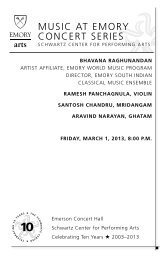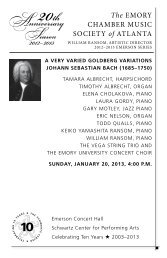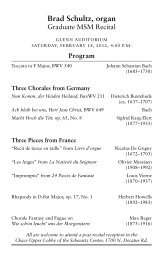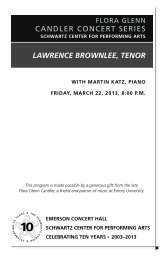CANDLER CONCERT SERIES - Arts at Emory - Emory University
CANDLER CONCERT SERIES - Arts at Emory - Emory University
CANDLER CONCERT SERIES - Arts at Emory - Emory University
Create successful ePaper yourself
Turn your PDF publications into a flip-book with our unique Google optimized e-Paper software.
ecame so well-known, their popularity quite possibly eclipsed the<br />
original folk songs on which they were based.<br />
Three Early Songs<br />
For a long time George Crumb has been a favorite of mine. Last<br />
summer, in a moment of absolute splendor listening to Gil (Kalish)<br />
speak <strong>at</strong> Menlo, P<strong>at</strong>rick (Castillo) played these pieces and I was instantly<br />
won over. It certainly helped th<strong>at</strong> Jan DeGaetani was his collabor<strong>at</strong>or<br />
on the recording, a mezzo I’ve revered since I discovered her singing<br />
while I was in the music recording library <strong>at</strong> Rice <strong>University</strong> in 2000.<br />
When you’re a student or even <strong>at</strong> the beginning of your career, it’s<br />
certainly helpful to see experienced artists with whom you feel a kinship.<br />
Crumb wrote much of his music for Gil and DeGaetani (lucky me!).<br />
Unlike the aural world and performance aesthetic you might associ<strong>at</strong>e<br />
with him, these songs are much more tuneful and intim<strong>at</strong>e. When I’ve<br />
played the songs for friends, they all say, “Oh th<strong>at</strong> doesn’t even sound<br />
like Crumb!” To give you an idea, in the last Crumb song I performed,<br />
the pianist tapped on the piano’s lid for accompaniment. In all of his<br />
music, though, there is a magic and sense of the cosmos, a truly original<br />
soundscape. He wrote Three Early Songs in 1947 to the poetry of Robert<br />
Southey and Sara Teasdale. He dedic<strong>at</strong>ed the songs to his wife, Elizabeth<br />
Brown, who did the first reading. Interestingly enough, his daughter,<br />
Ann, was l<strong>at</strong>er asked to record them on Bridge Records, so in Crumb’s<br />
words, “it was something of a completion.”<br />
—Sasha Cooke<br />
Shéhérazade<br />
In 1903, Maurice Ravel was inspired to set three of Tristan Klingsor’s<br />
poems as a song cycle titled Shéhérazade. In 1898 he had written an<br />
overture to a planned opera based on the Thousand and One Nights,<br />
also titled Shéhérazade. The opera was never finished, but some<br />
m<strong>at</strong>erials from the overture found their way into the song cycle.<br />
“The influence of Debussy is fairly obvious,” Ravel admitted. “Here<br />
again I yielded to the profound <strong>at</strong>traction which the East has always held<br />
for me since my childhood.” The longest of the three songs is the first, a<br />
c<strong>at</strong>alog of exotic delights from Asia. The text is separ<strong>at</strong>ed by brief piano<br />
interludes. The middle song, La flûte enchantée (The Magic Flute) has<br />
accompaniment reminiscent of Ravel’s ballet Daphnis and Chloë (1912).<br />
Ravel once suggested th<strong>at</strong> the final song, L’indifférent (The Indifferent<br />
One), was referring to his own personality.<br />
4



